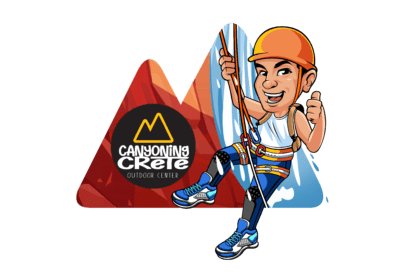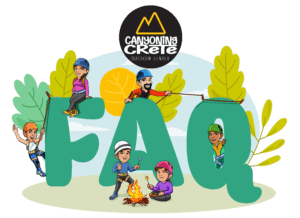Level 2 Autonomous
With our extensive experience spanning many years and a strong foundation in outdoor activities, we are well-equipped to provide flexible educational programs that prioritize the personal growth and development of each individual student as well as the group as a whole. Our programs are tailored to cater to different skill levels and experiences, ensuring that participants are appropriately placed within suitable levels. We employ specific objectives and implementation methods, including theoretical instruction, demonstrations, assignments, and practical training. This comprehensive approach ensures a well-rounded learning experience that fosters both knowledge acquisition and hands-on skill development.

ACADEMY LEVEL 2 AUTONOMOUS
Autonomous
Autonomous level 2 canyoning school, SFP1.
- Objective: This training program aims to equip participants with the necessary technical knowledge and skills to safely navigate moderately challenging canyons independently. Upon completion, trainees will be able to confidently and autonomously traverse canyons with a technical difficulty level of V3a2III, by group of minimum four autonomous participants. Additionally, they will possess the skills to progress individually in canyons with a difficulty level of v4-a3 with a guide or instructor. Trainees can further enhance their expertise through specialized thematic modules dedicated to specific technical skills. Trainees can further enhance their expertise through specialized thematic modules dedicated to specific technical skills.
- Duration: The training program spans a total of 7 days, consisting of practical descents in various gorges of Crete and fields, along with one afternoon dedicated to theoretical content and acquaintance. The training schedule is designed to provide participants with ample hands-on experience in real canyon environments. However, it is worth noting that the duration of the program may be adjusted based on the level of the respective group and prevailing weather conditions. This flexibility ensures that the training is tailored to the specific needs and capabilities of the participants, optimizing the learning experience while prioritizing safety and adaptability.
- Participants: The training school is designed for individuals who have completed at least the initiation level of canyoning and are 18 years of age or older. Participants must possess a good level of physical fitness, which should be certified by a medical certificate. It is also mandatory for participants to have accident insurance coverage throughout the duration of the training. The instructors hold the authority to make decisions regarding participant safety. If a participant's behavior poses a risk to themselves or the rest of the team, the instructors have the right to prohibit their continued participation in the training school. This measure is taken to ensure the overall safety and well-being of all participants involved. By setting these participation criteria, the training school aims to create a safe and suitable learning environment for individuals who meet the necessary prerequisites and are committed to adhering to safety guidelines.
- Certification: Upon successful completion of the training program, participants will be awarded the Canyoning Crete Outdoor Center certification. This certification serves as a recognition of their accomplishment and indicates that they have attained the necessary skills and knowledge to safely navigate technical canyons of limited difficulty. The Canyoning Crete Outdoor Center certification holds value beyond the training program itself. It allows participants to progress to further advanced level schools, take on leadership roles within canyoning teams, and pursue more challenging canyoning adventures with confidence. This certification serves as a stepping stone for participants to continue their canyoning journey and expand their skills and experiences in the field. The certification is a testament to the participants' dedication, hard work, and commitment to acquiring the necessary technical competence in canyoning. It is a valuable asset that showcases their capabilities and opens up opportunities for further growth and advancement within the canyoning community.
- Technical equipment: Fully provided (helmet, belt, carabiners, ropes, etc.). You will only need your personal items (tent and sleeping bag if needed, backpack, clothing, appropriate shoes).
- Cost: The participation fee for the school is set at 380 euros, including VAT. It is important to note that this fee covers the cost of the training program itself and does not include expenses related to travel, accommodation, and food. However, participants will have the advantage of being provided with personal downhill equipment at no additional cost. Transportation to the canyons will be arranged through private means, ensuring convenience and efficiency. For overnight stays, participants have two options: they can choose to arrange their own accommodations in rooms located near the canyons at their own expense, or they can opt for a rustic camping experience in anti-tents in the countryside. To ensure a personalized and focused learning environment, the maximum number of trainees per session is limited to eight people. Participation is granted on a first-come, first-served basis, so it is advisable to secure a spot early to guarantee your place in this exciting canyoning school.
Education themes
Techniques
- Guides Equipment knowledge: Learn about the equipment used by the Canyoning Leader, such as harnesses, helmets, and ropes.
- Setting up and Managing belay station "Relays": Gain the skills to independently set up and manage relays during canyoning descents without external assistance.
- Bag Management on Water Descents: Learn how to effectively manage your personal bag while navigating water descents, ensuring its security and not hindering your movement.
- Moving Safely on Slippery Terrain: Develop techniques to move safely on slippery surfaces encountered during canyoning, using proper footwork and balance.
- Transitioning between Ascending and Descending: Learn how to smoothly transition ascend and descend.
- Passing knots during Descents and Ascents: Acquire the skills to navigate on the rope during both descent and ascent in canyoning.
- Knots and Usage: Learn essential knots and their practical applications, including tying, Mickey, half hitch, hitch, figure of eight variations, bowline, etc.
- Self-Tightening Knots: Understand how to construct and use self-tightening knots, which provide added security and stability in certain situations.
- Self-Belaying Techniques: Gain proficiency in using self-security techniques to ensure personal safety during canyoning descents.
- Belaying from Above: Learn proper techniques for providing belay support from above, ensuring the safety of team members during canyoning activities.
Equipment
- Setup and Recall of “Auto moulinet” technique: Learn how to set up and use an approach rope system and reattract it to navigate through difficult terrain in canyon red zone. Understand the use and set up.
- “Released System” Installation and Operation: Gain knowledge on setting up and using a "released system" for controlled descents. Understand how to install and operate this system effectively.
- Top Rope Setup: Learn the technique of setting up a top rope system for belay support from above during rappelling or climbing.
- Installing a deviation: Acquire skills in installing a deviation to navigate challenging sections or obstacles in a canyon.
- Guided Rappel Setup: Learn how to set up a guided rappel system for additional control and guidance during descents.
- Placement and usage of descender from the bottom of a descend: Understand the technique of placing a detachable descender from the bottom to release a rappel rope or create a self-belay system.
- Belay station Check and Modification: Learn how to check and modify a “relay” for safety and functionality during canyoning operations.
- Friction Management Principles: Understand the principles of managing rope friction during rappelling and climbing. Learn different techniques for controlling friction in various situations.
- Equipment Capabilities and Usage: Gain knowledge about the capabilities and proper usage of canyoning equipment such as carabiners, harnesses, ropes, and descenders.
- Spit® Placement and Route Belay Basics: Learn the technique of placing a Spit® anchor and the basics of route belaying for added safety during canyoning.
Water movement
- "Reading" and Predicting Water Movements: Learn how to observe and interpret water movements in order to anticipate and navigate through different currents, eddies, and obstacles. Develop the ability to assess water conditions and make informed decisions based on your observations.
- Body Positions and Postures in the Water: Understand the importance of maintaining proper body positions and postures while in the water. Learn techniques to enhance stability, balance, and efficiency when swimming or maneuvering through currents.
- Assisting Team Members in Calm Waters: Acquire the skills to tow a team member who may be experiencing difficulty in calm waters. Learn appropriate techniques and communication methods to ensure their safety and effective assistance.
- Jumps: Practice and master the technique of performing jumps from a height of 5 meters. Understand the principles of proper takeoff, body positioning, and landing to ensure a safe and controlled jump.
Self- Security techniques
- Emergency Descent and Ascent without Mechanical Brakes: Learn how to perform emergency descents and ascents when mechanical brakes are not available. Acquire techniques to control speed and safely navigate the descent or ascent using alternative methods.
- Rope Cut from Above: Gain the skills to perform a rope cut from above, which may be necessary in emergency situations. Learn proper techniques to cut a rope safely and efficiently.
- Quick Uphill to Downhill Conversion: Learn how to quickly transition from uphill to downhill sections during canyoning. Develop the ability to adapt to changes in terrain efficiently and smoothly.
- Passing a Knot while Descending: Acquire the skills to navigate and pass a knot while descending on a rope. Learn techniques to safely maneuver around knots without compromising personal safety.
- Self-Safety during Descent: Learn self-Safety techniques while descending on a rope. Develop the ability to disengage from the rope in emergency situations or when necessary for personal safety.
First Aid
- Risks Associated with Stress: Understand the potential risks and effects of stress on individuals during canyoning activities. Learn how to recognize signs of stress in yourself and others, and develop strategies to manage stress in order to minimize potential hazards.
- Creating a Hot Spot and Placing Position: Learn how to create a hot spot, a safe and secure area where the individual can be placed while awaiting organized rescue. Acquire knowledge of proper techniques to ensure the comfort and safety during the waiting period.
- Basic CPR Steps
General Context
- Knowledge and Preparation of Collective Equipment: Understand the various collective equipment used in canyoning, such as ropes, harnesses, carabiners, and helmets. Learn how to properly inspect, prepare, and maintain this equipment to ensure its safety and functionality during descents.
- Map and Mapping Knowledge and Management: Acquire knowledge of maps and map reading skills relevant to canyoning. Learn how to interpret and navigate using topographic maps, understand symbols and contour lines, and plan routes effectively. Develop the ability to manage maps during descents to ensure proper orientation and direction.
- Organization of Descent: Learn how to effectively organize and plan canyoning descents. Understand the importance of proper communication, coordination, and teamwork within the group. Learn techniques for assigning roles and responsibilities, establishing clear guidelines, and ensuring the safety and well-being of all participants throughout the descent.
Theoretical Courses
In the seminar, there are two lectures that cover essential areas of knowledge for canyoners to safely navigate canyons of technical difficulty V3.a2.II. These lectures provide important theoretical foundations to complement practical skills. This lectures focuses on understanding the geology and hydrology of canyons, risks and hazards, weather patterns and rope management and techniques.

